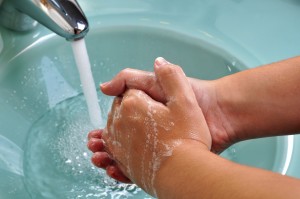Antibiotics prescribed by doctors are linked to rising numbers of serious bacterial infections that can cause severe diarrhea in children, according to a study by the Centers for Disease Control and Prevention. The study, recently published in the journal Pediatrics, found that 71 percent of Clostridium difficile infections in children 1 to 17 developed soon after the children took antibiotics prescribed in doctors’ offices to treat other conditions. Most of the children had gotten antibiotics to treat ear, sinus and upper respiratory infections.
Previous studies had shown that 50 percent or more of antibiotic prescriptions are given to treat upper respiratory infections, which do not require antibiotics, according to the CDC.
Some 17,000 children get C. difficile infections every year in the United States. C. difficile is a bacterium that causes diarrhea ranging from mild to life-threatening. The bacterium is often present in small numbers in a healthy gut; but when people take antibiotics, competing species can be wiped out, leading to an overpopulation of C. difficile.
Mild symptoms of C. difficile infection can include watery diarrhea several times a day for a few days, with abdominal pain. More severe cases can produce watery diarrhea many times a day, severe abdominal pain, fever, loss of appetite and blood or pus in the stool.
The CDC study found that white children, and those between 12 and 23 months, are at greatest risk for the infection.
Taking antibiotics is the biggest risk factor for C. difficile infections in both children and adults, according to the study. The CDC urged doctors to follow antibiotic-prescribing guidelines, and it advised parents not to demand that doctors prescribe antibiotics.
The typical C. difficile patient is older, on antibiotics and hospitalized; but in recent years, doctors have seen alarming increases in the number of cases of C. difficile diarrhea in children who are not hospitalized.
When C. difficile bacteria multiply, they produce toxins that can damage the lining of the gut. Hundreds of thousands of people are hospitalized annually in the U. S. due to C. difficile infections, resulting in thousands of deaths, according to the CDC. A 2012 study found that the number of infections from C. difficile had increased more than twelve times from the 1991-1997 time period, to the 2004-2009 time period. In addition to C. difficile rates rising rapidly, doctors find that the illness is becoming harder to treat (resulting in a growing proportion of deaths).
Preventing or Reducing Risk of Clostridium Difficile Infection in Children
Other than limiting antibiotics only to times when they are absolutely necessary, doctors say that frequent, proper washing of caregiver and children’s hands with soap and water can go a long way toward avoiding infections of the gastrointestinal tract. Soap and water work best, as opposed to alcohol-based hand sanitizers, which do not remove all C. difficile spores. Hand-washing after using toilet and before eating are essential. Proper handling of soiled diapers is also important. Probiotics have also proven helpful for preventing GI tract infections in some children.
By Eirian Hallinan
Related Posts:
- Is Vitamin D Important for Reducing Ear Infection Risk in Young Children?
- Children and Illness: The Main Reasons that Kids Miss School
- Losing Sleep Linked to Higher Blood Pressure in Youths
- Energy Drinks and Sports Drinks Linked to Unhealthy Behaviors in Teenagers
- Opioid Overdoses Triple Among Kids & Teens – How to Protect Your Kids
